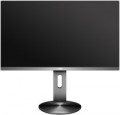Colour depth
The colour depth supported by the monitor.
This parameter characterizes the number of shades that the screen can display. And here it is worth recalling that the image in modern monitors is based on 3 basic colours — red, green, blue (RGB scheme). And the number of bits is indicated not for the entire screen, but for each base colour. For example, 6 bits (the minimum colour depth for modern monitors) means that the screen is capable of producing 2 ^ 6, that is, 64 shades of red, green and blue; the total number of shades will be 64 * 64 * 64 = 262,144 (0.26 million). An
8-bit colour depth (256 shades for each base colour) already gives a total of 16.7 million colours; and the most advanced modern monitors support
10-bit colour, allowing you to work with more than a billion shades.
Screens with support for FRC technology are worth a special mention; nowadays, you can find models marked "
6 bit + FRC " and "
8 bit + FRC ". This technology was developed to improve picture quality in situations where the incoming video signal has a greater colour depth than the screen, such as when 10-bit video is fed to an 8-bit matrix. If such a screen supports FRC, the picture on it will be noticeably better than on a regular 8-bit monitor (although somewhat worse than on a full-fledged 10-bit monitor, but “8 bit + FRC” screens are much
...cheaper).
High colour depth is important primarily for professional graphics and other tasks that require high colour fidelity. On the other hand, such features significantly affect the cost of the monitor. In addition, it is worth remembering that the quality of colour reproduction depends not only on the colour depth, but also on other parameters — in particular, colour gamut (see below).Portrait pivot
The screen is 90° rotatable on a stand, from landscape (horizontal) to portrait (vertical). The vertical orientation of the screen (
portrait mode) can be useful, for example, when working with large documents made in portrait orientation.
Screen rotation
The presence of
a swivel stand in the design of the monitor allows you to change not only the angle of the screen (of course everyone has it), but also its rotation to the right and left. The angle of rotation depends on the model, but anyway, even a slight deviation allows you to quickly adjust the position of the monitor to your needs.
Height adjustment
The ability to move the monitor screen up and down relative to the base. This feature is very convenient for
adjusting the height of the screen — moving it on the mount is much easier than looking for a stand or resorting to other tricks.
USB hub 3.x
The monitor has a USB hub with USB 3.2 connectors.
A USB hub is a set of additional USB ports on the monitor case, to which you can connect various peripherals (provided that the monitor is connected to the computer's USB port with a special cable). This equipment performs two useful functions. Firstly, the hub increases the number of ports available for connection: the USB cable from the monitor occupies only one port on the computer, and in return the user receives several connectors on the monitor. Secondly, these connectors are located in close proximity to the user, literally at arm's length. This is especially useful when working with classic PCs, where the system unit can be located under the table or in another hard-to-reach place, and it would be inconvenient to reach for it every time in search of USB ports.
As for version 3.2, it combines all versions of the third generation. In fact, this standard includes three specifications: USB 3.2 Gen 1 (formerly USB 3.0) with speeds up to 5 Gbps, USB 3.2 Gen 2 (formerly USB 3.1) with speeds up to 10 Gbps and USB 3.2 Gen 2x2 with speeds up to 20 Gb /with. The USB 3.x hub in the monitor can meet any of these specifications, such details should be clarified separately.
Fast charge
Availability in the monitor USB port with function of
fast charging. This connector is used to charge batteries in various gadgets (smartphones, tablets, etc.). It differs from conventional USB ports in increased power supply; in addition, this connector may not support any other functions at all, except for charging.
Note that in modern technology various special technologies can be used to speed up the charging process. So before buying a monitor with this feature, it doesn't hurt to check if it supports any of these technologies and whether they will be compatible with devices that you plan to charge.

